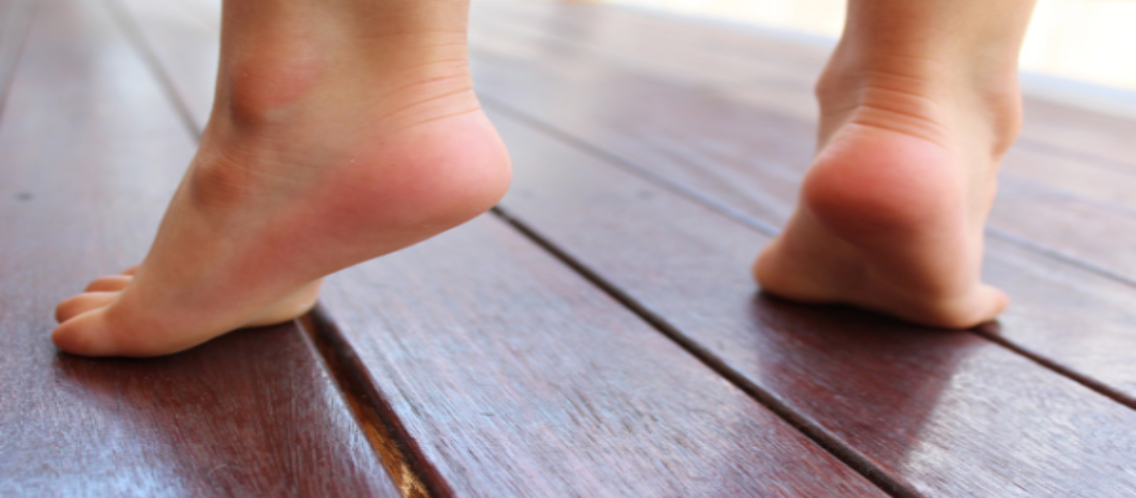Toe Walking: What Causes it and How You Can Help Your Child

Toe walking. It’s one of the most difficult and common child development issues I run across in my pediatric therapy practice.
I have to admit, every time a preschool teacher comes to me and says, “I think you need to take a look at this student, he is really up there on his toes”, I cringe a little bit. And here’s why– toe walking can range from a totally normal developmental phase to a BIG problem. Here are some thoughts on this very common developmental issue.
What is Toe Walking?
Toe walking simply means that a child walks on his tip toes or doesn’t contact the ground with his heel first when taking a step. This is considered “normal” until sometime between the ages of 2 and 3. Beyond that age, without any definitive medical reason, it is considered idiopathic toe walking, or toe walking without a known cause – simply a habit the child has developed.
Toe Walking Causes
The definition of toe walking is simple, but what’s not so simple about habitual toe walking is WHY? There are many possible reasons that children might develop a toe walking pattern and the research does not definitively point to one specific cause.
Are they exhibiting tactile defensiveness in their feet? Is there a proprioceptive or vestibular problem? Or could toe walking be a warning sign of a neurological disorder like cerebral palsy or muscular dystrophy? Could it be a sign of autism? Is the child’s calf musculature so tight that he can’t put his heel down? Is this simply a habit that could eventually lead to tight calf musculature and the inability to put the heel down?
But not every child who walks on his toes has a serious diagnosis coming down the pike. I have seen several kiddos that simply outgrow the toe walking pattern. Some research indicates that children will usually outgrow it by the age of 5.
Most often, if a child is showing no signs of developmental delay other than toe walking, he will outgrow this pattern and continue with typical development. As therapists, we are more concerned when toe walking is accompanied by additional sensory processing concerns or other developmental issues.
Treatment for Toe Walking
Many parents wonder how to stop toe walking in their children. Therapeutic treatment for toe walking depends on what the cause is, how strong of a habit it is (do they ever contact the ground with their heels, or are they on their toes all the time?), how tight the gastrocnemius muscles (calf muscles) have become, and what other changes have occurred in the child’s foot and ankle muscles as a result of walking this way.
Treatment methods can include stretching, serial casting (a series of casts applied over time that gradually stretch the heel cords), or botox injections (used to temporarily paralyze the calf muscle so that it is easier to stretch). Bracing can also be used to limit movement, preventing the child from getting up onto his toes (in milder cases, stiff boots or high top tennis shoes can sometimes have the same effect).
In rare and severe cases, surgical lengthening is also an option for treatment. If the toe walking is caused by a sensory issue related to the child’s inability to tolerate the feeling of the ground on his feet, sensory interventions can be introduced and may include the Wilbarger brushing protocol, proprioceptive input via vibration or deep pressure to the feet or shoulders.
Ultimately, the reasons behind toe walking are often difficult to determine. Even after 15 years of experience in pediatrics, I find this to be one of the most difficult issues of child development to get to the bottom of and to treat.
There are many conflicting views about which treatments work and which ones don’t. My opinion is that every child is different and will respond differently to any given treatment. What works for one may not work at all for another. Either way, toe walking is definitely something to be aware of and to monitor.
What Should You Do?
If your child is over the age of two and walking on his toes regularly, it wouldn’t hurt to consult your pediatrician. You may simply be told that he or she will outgrow it and that may be true…or maybe not. Are there other sensory processing or developmental concerns? Are you noticing other motor concerns? Are your child’s heel cords getting so tight that he can’t even stand on flat feet if he tries?
If you’re concerned, be sure to speak up at your next appointment with your pediatrician. Be an advocate for your child – you know him better than anyone! Get things taken care of before something small turns into something that will take more serious measures to correct.
Lauren Drobnjak
Πρόσφατα Άρθρα
Splish, Splash, the Benefits of Water Play for Children
Independent Play can Boost Confidence, Creativity, and So Much More
